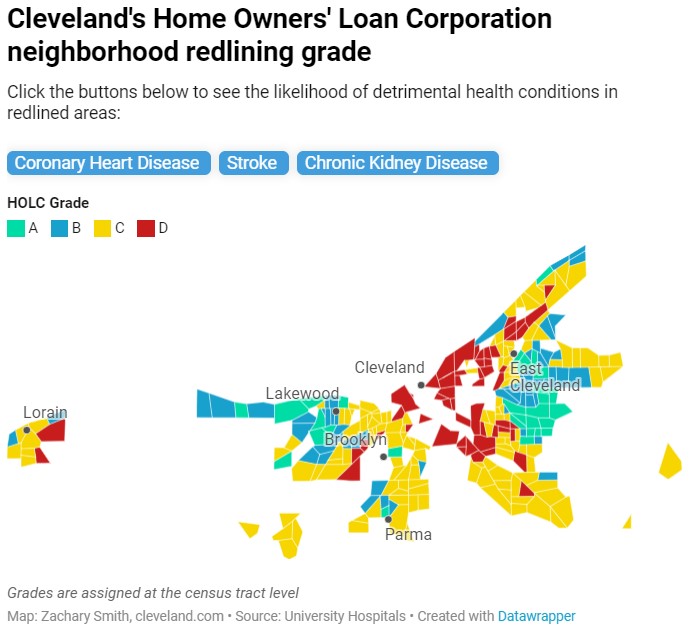The idea that people of low-income experience shorter life spans and higher rates of chronic disease does not necessarily come as much of a surprise. So it’s not shocking that living in a low-income neighborhood would also increase your chances of illness and premature death.
However, researchers from University Hospitals in Cleveland recently took it a step further, demonstrating that, among the many predictors of cardiovascular disease – one of them is whether your address falls in one of the neighborhoods that long ago was affected by discriminatory lending practices known as redlining.
“What’s surprising to me is that every city that I’ve looked into, there is significant residential segregation. … And no matter where you look, the relationship holds between the grading of the neighborhood (loan) risk and cardiometabolic health,” said the study’s lead author, Dr.Sadeer Al-Kindi, a cardiologist at University Hospitals.
What Al-Kindi is referring to is the Home Owners’ Loan Corp. grading system, which classified residents of a particular area and the amount of risk they posed to banks and other lenders.
The system used letter grades A, B, C and D, A being the best and D being the worst. Areas classified as D were outlined in red. These “redlined” areas, consisting mainly of immigrants and people of color, were considered the highest loan risk — and consequently, banks rarely made loans to its residents. The process, contributed to maintaining high levels of poverty — and consequently poor health –for decades to come, reseach has shown.
And that’s just what Al-Kindi and the other researchers at UH’s Harrington Heart and Vascular Institute found: a direct relationship between redlined areas and heart health. Patients with the greatest number of cardiac risk factors and worst health outcomes were living today in the same geographic areas designated with the lowest lending scores many decades earlier.
“We saw a dose response effect between the grading and the worsening degree of cardiometabolic health,” he said.
It’s an effect Al-Kindi said is surprisingly robust across very different cities in all parts of the country, and remains significant even after adjusting for differences in race, age, gender and air quality. Al-Kindi went on to say that Cleveland and Detroit, for example, show similar trends of redlining and prevalence of coronary diseases.
This isn’t the first time poor health outcomes have been connected to redlining. Earlier research had shown that residents who live in formerly redlined areas have decreased lifespans, increased infant mortality and pre-term birth rates, and increased incidence of a host of chronic diseases, including diabetes, high blood pressure, mental health disorders, asthma, and some cancers.
The UH work was published this month, adding coronary heart disease, stroke prevalence, and chronic kidney disease to that list.
“Really not much had been done in the cardio-metabolic space,” Al-Kindi said, adding that the long-term health implications offered an “opportunity for us to learn from history.”


2023 Hyundai Elantra Hybrid will surprise you (review)
We are living in the age of cynicism, when everyone seems jaded, as if nothing surprises us anymore. So, when something does deliver more than you’d expect, it’s a genuine delight. Such is the case with 2023 Hyundai Elantra Hybrid Limited compact sedan, starting...
Robert Oppenheimer, father of the atomic bomb, wrongly stripped of security clearance, US says
The Biden administration has reversed a decades-old decision to revoke the security clearance of Robert Oppenheimer, the physicist called the father of the atomic bomb for his leading role in World War II’s Manhattan Project. U.S. Energy Secretary Jennifer Granholm...
Powerball: See the winning numbers in Saturday’s $149 million drawing
It’s time to grab your tickets and check to see if you’re a big winner! The Powerball lottery jackpot continues to rise after one lucky winner in Kansas won $93 million in the November 19 drawing. Is this your lucky night? Here are Saturday’s winning lottery numbers:...
US charges Sam Bankman-Fried with defrauding investors
The US Securities and Exchange Commission (SEC) has charged Sam Bankman-Fried with "orchestrating a scheme to defraud investors" in the failed cryptocurrency exchange FTX. The former FTX boss was arrested on Monday. Mr Bankman-Fried built a "house of cards on a...
Submit your event
We will be happy to share your events. Please email us the details and pictures at publish@profilenewsohio.com
Address
P.O. Box: 311001 Independance, Ohio, 44131
Call Us
+1 (216) 269 3272
Email Us
Publish@profilenewsohio.com

